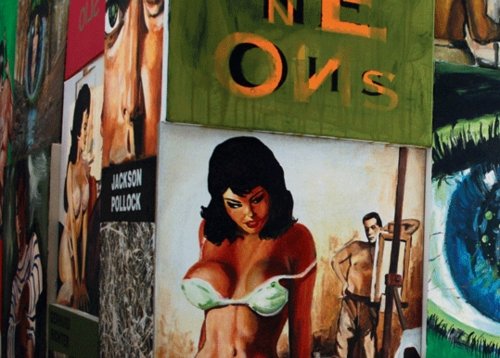Pascal Rousson
dal 20/7/2008 al 12/9/2008
Segnalato da
20/7/2008
Pascal Rousson
Vegas Gallery, London
The house of pain

For his first solo show, Swiss/French artist Pascal Rousson presents work
which elaborates upon Museum of the Dispossessed, an installation previously
exhibited at Vegas Gallery as part of the Loose Booty exhibition.
Rousson's work ironically debunks the ideologies and values embedded in
Modernist art. His current installation scavenges elements and themes from
his own work, including flea market and charity shop paintings reworked with
satirical references to canonical Western artists, an interest in the
metaphorical potential of American pulp and amateur D.I.Y. craft-making
manuals, and a preoccupation with the constricting myth of The Great Artist
as Rock Star, destined to burn out and leave a trail of beautiful,
history-altering corpses.
Museum of the Dispossessed incorporated paintings, which appropriated covers
of the late 1960s D.I.Y. magazine Practical Householder. The paintings
presented comical narratives that cast American modernist artists as
self-obsessed bricoleurs with nameless and compliant female sidekicks, whose
great works echo by the "low" aesthetics of amateur home improvement
projects. Through juxtapositions of imagery and text within the canvas
frames, and through their status as components of an installation rather
than singular art objects, the paintings challenged the concept of art and
artists as self-contained entities by foregrounding plural presences,
influences and voices inhabiting the installation.
In his latest work Rousson extends the D.I.Y metaphor into darker territory.
In the centre of the gallery stands a structure resembling a garden shed,
constructed from a skin of closely packed paintings that mix references to
canonical artists with American pulp novel cover art, teenage bedroom
aesthetics and trippy pop surrealist-inflected imagery.
Traces of the artist as sinister loner, blazing comet and petty criminal
reverberate through the structure. Rousson rams textual references to famous
artists (Andy Warhol, Christopher Wool, Dan Flavin, and Sigmar Polke)
against snippets of kitschy science-fiction landscapes that mock the
hallowed inner-space model of artistic imagination, and lurid Russ Meyer
style mannequins disrobing for virile men wielding palettes and paintbrushes
in place of guns.
These latter images are copied and reinterpreted from American pulp novel
covers to emphasise the macho dynamic entrenched in artistic production by
high-priests of the canon including Picasso and Pollock. Threaded through
the installation, a group of paintings that reproduce a famous photograph of
Picasso in a stereotypically French striped sweater and underwear extend the
dissection of this dynamic by turning the artist into an auto-erotic
spectacle entranced by his masculinity and nationality.
The pulp imagery highlights another satirising device, the character of the
criminal anti-hero, culled from the "noir" films and novels which
Roussonadmires. This character dovetails into the installation's
reference to the
deceptive nature of a film set, which sets the stage for a presentation of
artists as self-mythologizing thieves of ideas and images. The
installation's garden shed silhouette ties into this strand of associations
by conjuring a spectre of a solitary hunter-gatherer obsessive exemplified
by Theodore Kaczynski, The Unabomber, cobbling together lethal missives.
Kaczynski's disturbed actions represent the epitome of a solipsistic
life-performance with devastating consequences, a grotesque parody of
artistic subversion.
Drawing on a musical metaphor, Rousson describes the installation as a cover
version of Kaczynski's remote cabin. It is a hybrid unit, a shed that
doubles as a large, three-dimensional canvas made of jammed-together
articles. Each element acquires meaning relationally, from other elements.
Shapes, objects, text, imagery and colours reconfigure into wisecracks,
insinuations and combinations that are literally on the surface.
This surface, evocative of a salon-style bedroom poster display, alludes to
a past-tense idyll of adolescent rebellion. Rousson mocks art's dissident
vision of itself by comparing it to a secret teenage bedroom garden of
jumbled, fomenting drives and intoxication. The paintings' enamel veneer
also puns on teeth, which, in the vocabulary of pop-psychological dream
analysis, signify sexual neurosis. This added layer of textual-visual
repartee circles back to a caustic joke, which sticks another knife into the
fiction of originality at the heart of the great artist myth.
Viewers stepping inside the installation encounter empty and uninhabited
square footage lined with the raw backs of painted canvases reminiscent of
the trickery of painted film set facades. A popular conception of the
artist, portrayed in films such as Lust for Life, depicts him as possessed,
literally occupied by an inspired spirit that creates and self-destructs.
The installation's interior slyly exposes this story. Its blank inside
highlights the "beautiful illusion" of the art object, which appears
self-supporting and erect but is, in fact, created and kept aloft by a
network of supporting devices and performers traditionally hidden from view.
Text by Aline Duriaud
Private View: Thursday 21 August 18.00-21.00
Closing Party: 13 September 18.00-21.00
Vegas Gallery
Oaklands 64-66 Redchurch Street- London
open wednesday-saturday 12.00-18.00
free admission



